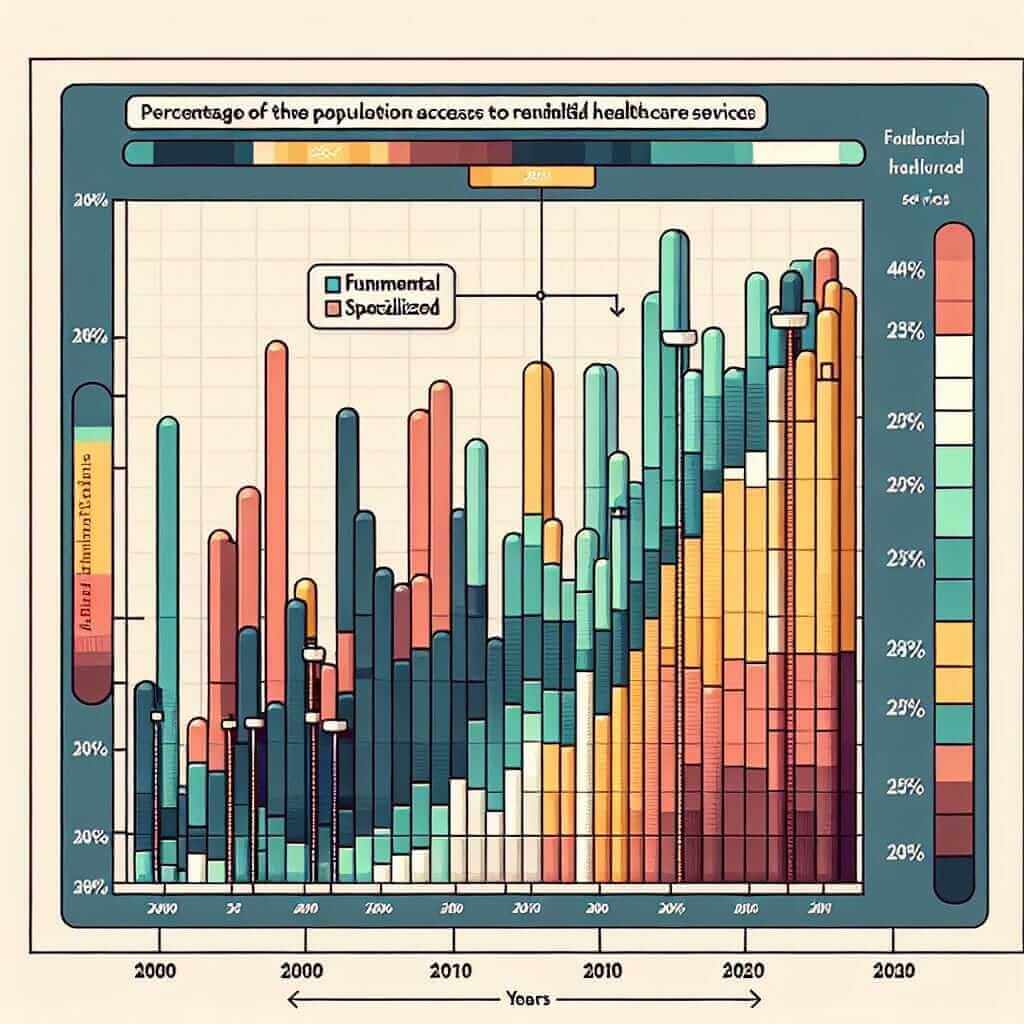The IELTS Writing Task 1 often presents data on global issues, and healthcare access is a recurring theme. Understanding how to interpret and write about healthcare statistics is crucial for IELTS success. This article will guide you through analyzing data on “Healthcare Access in Different Regions (2000-2023),” focusing on equipping you with the skills to achieve a Band 7+ score.
Sample IELTS Writing Task 1 Question
You should spend about 20 minutes on this task.
The table below shows the percentage of the population with access to essential healthcare services in three different regions between 2000 and 2020.
Summarise the information by selecting and reporting the main features, and make comparisons where relevant.
| Region | Year | Access to Basic Healthcare (%) | Access to Specialized Care (%) |
|---|---|---|---|
| Region A | 2000 | 45 | 20 |
| 2010 | 60 | 35 | |
| 2020 | 75 | 50 | |
| Region B | 2000 | 70 | 40 |
| 2010 | 75 | 50 | |
| 2020 | 80 | 60 | |
| Region C | 2000 | 25 | 10 |
| 2010 | 30 | 15 | |
| 2020 | 35 | 20 |

Data Analysis
The table illustrates the disparity in healthcare access across three regions over two decades. Region B consistently demonstrates the highest percentage of its population with access to both basic and specialized healthcare, while Region C lags significantly behind.
Model Answer
The provided table presents a clear picture of the changing landscape of healthcare access in three distinct regions between the years 2000 and 2020. The data highlights a noticeable gap in access levels, with Region B enjoying the most favorable situation and Region C facing the most significant challenges.
In 2000, Region B boasted the highest percentage of the population with access to basic healthcare services at 70%, followed by Region A at 45% and Region C at a mere 25%. This pattern of disparity continued throughout the following decades. By 2020, Region B had increased its access to basic healthcare to 80%, while Region A saw a commendable rise to 75%. However, Region C continued to lag behind, only managing to reach 35% access.
A similar trend is observed when analyzing access to specialized care. Region B maintained its lead, starting at 40% access in 2000 and reaching 60% by 2020. Region A showed progress, moving from 20% to 50% access over the same period. Region C, unfortunately, remained significantly underserved, with only 20% of its population having access to specialized care in 2020.
In conclusion, while all regions experienced some improvement in healthcare access, the gap between the most and least served regions remained substantial, highlighting persistent inequalities in healthcare provision. (Word Count: 194)
Key Points for Writing Task 1
- Paraphrase: Avoid simply copying the question. Rephrase key information in the introduction and throughout your response.
- Overview: Provide a concise overview of the main trends and differences in the data.
- Selective Detail: Don’t describe every single data point. Focus on the most significant changes and comparisons.
- Accurate Language: Use appropriate vocabulary to describe trends (increase, decrease, fluctuate, plateau, etc.) and make comparisons (significantly higher, considerably lower, etc.).
- Grammar and Structure: Use a variety of sentence structures and grammatical constructions to demonstrate language proficiency.
- Concision: Be clear and to the point. Aim for a word count of 150-190 words.
Essential Vocabulary
- Disparity (noun /dɪˈspær.ə.ti/): a great difference
- Access (noun /ˈæk.ses/): the right or opportunity to use something
- Essential (adjective /ɪˈsen.ʃəl/): extremely important and necessary
- Specialized (adjective /ˈspeʃ.əl.aɪzd/): designed or developed for a particular purpose
- Trend (noun /trend/): a general direction of change
Conclusion
Mastering IELTS Writing Task 1 requires a combination of analytical and language skills. By familiarizing yourself with common healthcare-related vocabulary, understanding data interpretation techniques, and practicing writing clear and concise summaries, you can confidently approach this section of the IELTS exam and aim for a Band 7+ score.